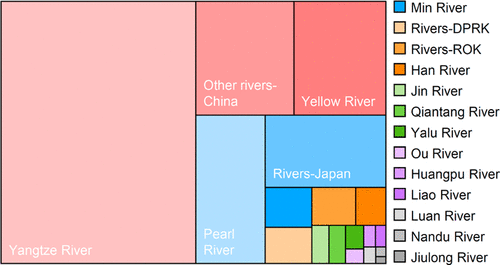当前位置:
X-MOL 学术
›
Environ. Sci. Technol.
›
论文详情
Our official English website, www.x-mol.net, welcomes your
feedback! (Note: you will need to create a separate account there.)
Observation-Based Mercury Export from Rivers to Coastal Oceans in East Asia
Environmental Science & Technology ( IF 10.8 ) Pub Date : 2021-10-07 , DOI: 10.1021/acs.est.1c03755 Maodian Liu 1, 2 , Qianru Zhang 1, 3 , Chenghao Yu 1 , Liuliang Yuan 1, 4 , Yipeng He 5 , Wenjie Xiao 6, 7 , Haoran Zhang 1 , Junming Guo 8 , Wei Zhang 9 , Yanbin Li 10 , Qianggong Zhang 11 , Long Chen 12 , Xuejun Wang 1
Environmental Science & Technology ( IF 10.8 ) Pub Date : 2021-10-07 , DOI: 10.1021/acs.est.1c03755 Maodian Liu 1, 2 , Qianru Zhang 1, 3 , Chenghao Yu 1 , Liuliang Yuan 1, 4 , Yipeng He 5 , Wenjie Xiao 6, 7 , Haoran Zhang 1 , Junming Guo 8 , Wei Zhang 9 , Yanbin Li 10 , Qianggong Zhang 11 , Long Chen 12 , Xuejun Wang 1
Affiliation

|
Globally, the consumption of coastal fish is the predominant source of human exposure to methylmercury, a potent neurotoxicant that poses health risks to humans. However, the relative importance of riverine inputs and atmospheric deposition of mercury into coastal oceans remains uncertain owing to a lack of riverine mercury observations. Here, we present comprehensive seasonal observations of riverine mercury and methylmercury loads, including dissolved and particulate phases, to East Asia’s coastal oceans, which supply nearly half of the world’s seafood products. We found that East Asia’s rivers annually exported 95 ± 29 megagrams of mercury to adjacent seas, 3-fold greater than the corresponding atmospheric deposition. Three rivers alone accounted for 71% of East Asia’s riverine mercury exports, namely: Yangtze, Yellow, and Pearl rivers. We further conducted a metadata analysis to discuss the mercury burden on seawater and found that riverine export, combined with atmospheric deposition and terrestrial nutrients, quantitatively elevated the levels of total, methylated, and dissolved gaseous mercury in seawater by an order of magnitude. Our observations support that massive amounts of riverine mercury are exported to coastal oceans on a continental scale, intensifying their spread from coastal seawater to the atmosphere, marine sediments, and open oceans. We suggest that the impact of mercury transport along the land–ocean aquatic continuum should be considered in human exposure risk assessments.
中文翻译:

基于观测的东亚从河流到沿海海洋的汞输出
在全球范围内,沿海鱼类的消费是人类接触甲基汞的主要来源,甲基汞是一种对人类健康构成威胁的强效神经毒物。然而,由于缺乏河流汞观测,河流输入和汞在大气中沉积到沿海海洋的相对重要性仍然不确定。在这里,我们展示了东亚沿海海洋中河流汞和甲基汞负荷的综合季节性观察结果,包括溶解阶段和颗粒阶段,东亚沿海海洋供应了世界近一半的海鲜产品。我们发现东亚的河流每年向邻近海域输出 95 ± 29 兆克的汞,是相应的大气沉积量的 3 倍。仅三条河流就占东亚河流汞出口的 71%,即:长江、黄河和珠江。我们进一步进行了元数据分析以讨论海水中的汞负担,发现河流出口,加上大气沉降和陆地养分,使海水中的总汞、甲基化汞和溶解气态汞的含量在数量上提高了一个数量级。我们的观察结果表明,大量的河流汞出口到大陆尺度的沿海海洋,加剧了它们从沿海海水向大气、海洋沉积物和公海的扩散。我们建议在人类暴露风险评估中应考虑汞沿陆地-海洋水生连续体迁移的影响。将海水中的总汞、甲基化汞和溶解气态汞的含量定量提高了一个数量级。我们的观察结果表明,大量的河流汞出口到大陆尺度的沿海海洋,加剧了它们从沿海海水向大气、海洋沉积物和公海的扩散。我们建议在人类暴露风险评估中应考虑汞沿陆地-海洋水生连续体迁移的影响。将海水中的总汞、甲基化汞和溶解气态汞的含量定量提高了一个数量级。我们的观察结果表明,大量的河流汞出口到大陆尺度的沿海海洋,加剧了它们从沿海海水向大气、海洋沉积物和公海的扩散。我们建议在人类暴露风险评估中应考虑汞沿陆地-海洋水生连续体迁移的影响。
更新日期:2021-10-19
中文翻译:

基于观测的东亚从河流到沿海海洋的汞输出
在全球范围内,沿海鱼类的消费是人类接触甲基汞的主要来源,甲基汞是一种对人类健康构成威胁的强效神经毒物。然而,由于缺乏河流汞观测,河流输入和汞在大气中沉积到沿海海洋的相对重要性仍然不确定。在这里,我们展示了东亚沿海海洋中河流汞和甲基汞负荷的综合季节性观察结果,包括溶解阶段和颗粒阶段,东亚沿海海洋供应了世界近一半的海鲜产品。我们发现东亚的河流每年向邻近海域输出 95 ± 29 兆克的汞,是相应的大气沉积量的 3 倍。仅三条河流就占东亚河流汞出口的 71%,即:长江、黄河和珠江。我们进一步进行了元数据分析以讨论海水中的汞负担,发现河流出口,加上大气沉降和陆地养分,使海水中的总汞、甲基化汞和溶解气态汞的含量在数量上提高了一个数量级。我们的观察结果表明,大量的河流汞出口到大陆尺度的沿海海洋,加剧了它们从沿海海水向大气、海洋沉积物和公海的扩散。我们建议在人类暴露风险评估中应考虑汞沿陆地-海洋水生连续体迁移的影响。将海水中的总汞、甲基化汞和溶解气态汞的含量定量提高了一个数量级。我们的观察结果表明,大量的河流汞出口到大陆尺度的沿海海洋,加剧了它们从沿海海水向大气、海洋沉积物和公海的扩散。我们建议在人类暴露风险评估中应考虑汞沿陆地-海洋水生连续体迁移的影响。将海水中的总汞、甲基化汞和溶解气态汞的含量定量提高了一个数量级。我们的观察结果表明,大量的河流汞出口到大陆尺度的沿海海洋,加剧了它们从沿海海水向大气、海洋沉积物和公海的扩散。我们建议在人类暴露风险评估中应考虑汞沿陆地-海洋水生连续体迁移的影响。













































 京公网安备 11010802027423号
京公网安备 11010802027423号